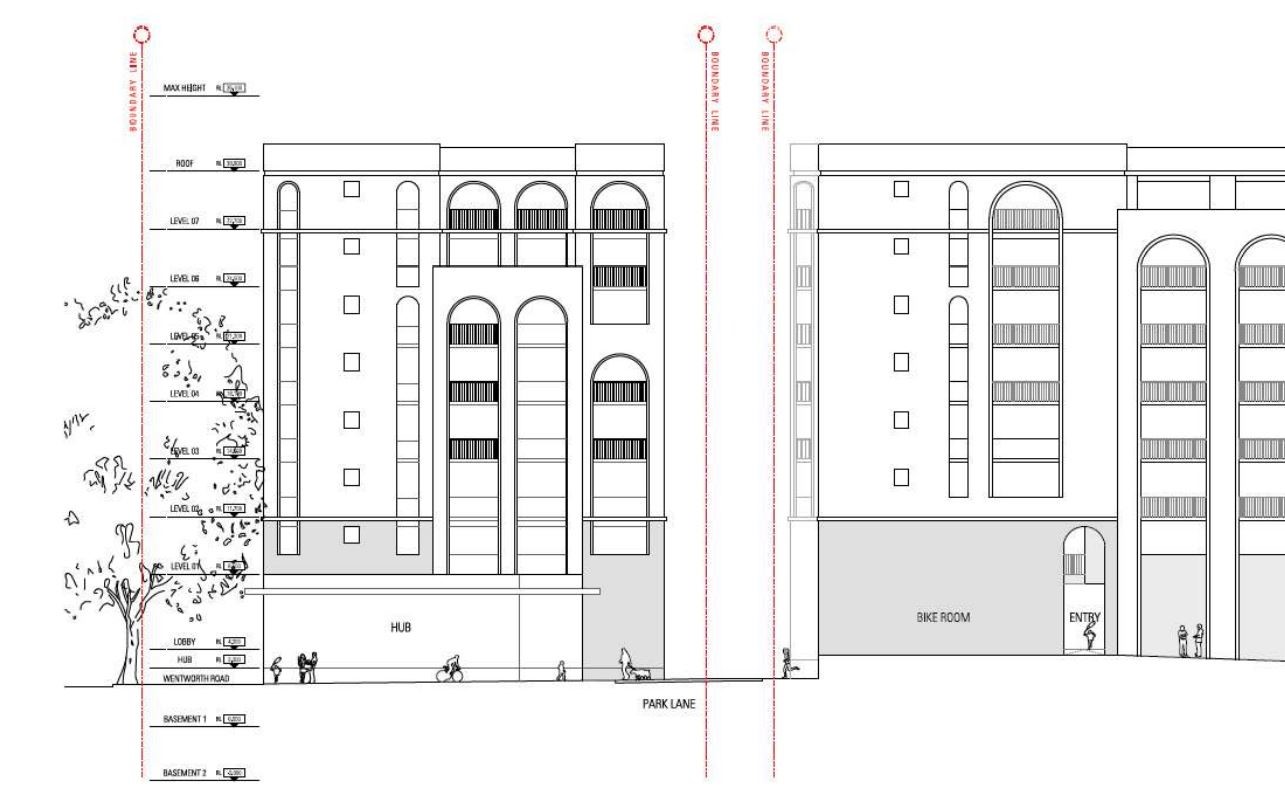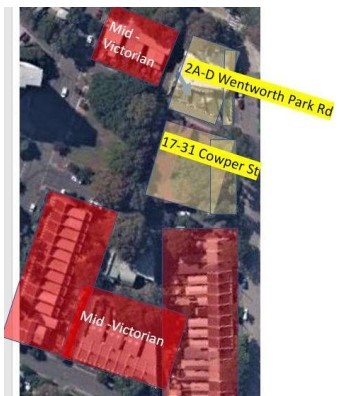by Ian Stephenson, Planning Convenor, from Bulletin 1 of 2021

Numbers 17-31 Cowper St and 2A-D Wentworth Park Rd are part of the St Phillips Heritage Conservation Area. The current height limit is nine metres. To construct tall buildings, a spot rezoning is necessary. The Society has objected to the rezoning application as has the National Trust.
The Trust noted
it is a bad precedent to simply modify the boundary of a Heritage Conservation Area (HCA) to allow development that would otherwise be considered unsympathetic and not contributing to the cultural values of the place.
Heritage Conservation Areas are vulnerable to edge effects. Those areas closest to the boundary suffer the greatest from development outside the HCA. Further encroachment into a HCA will result in the erosion of the HCA’s integrity. The scale of an adjacent development that is outside of a conservation area cannot be used as a precedent for inappropriate work within a HCA – this is the whole purpose of such boundaries.

These are very wise observations. A copy of the National Trust’s objection can be read here: https://www.glebesociety.org.au/national-trust-submission-re-hca-rezoning-2021/.
In response to concerns raised by the President of the Society with the Lord Mayor about the rezoning, Andrew Thomas, Acting Director City Planning/Development/Transport advised that
an independent heritage impact assessment has been prepared for NSW Land and Housing Corporation. That assessment concludes that demolishing the existing buildings will have a negligible impact on the significance of the heritage conservation area and that the proposal to remove the subject site from the conservation area would be an acceptable heritage outcome. Mr Thomas’s letter can be viewed here: https://www.glebesociety.org.au/cos-thomas-letter-re-hca-rezoning-november-2020/
The Society included in its objection a detailed critique of the Heritage Impact Assessment commissioned by LAHC and found it was based on inadequate research, contained errors of fact and was flawed in its conclusions. This view was supported by the eminent conservation architect Dr Clive Lucas OBE and the distinguished architectural historian Dr James Broadbent AM.
The Society’s objection can be read in full at https://www.glebesociety.org.au/wp-content/uploads/TGSI-Cowper-St-objection-7-Dec-2020.pdf. An example of the specious argument in the Heritage Assessment is the statement ‘the site is located within a pocket of varied architectural styles and densities of development and that interpreting the existing buildings as cohesive with the values of the conservation area are less applicable.’ Numbers 17-31 Cowper St and 2A-D Wentworth Park Rd, in fact, adjoin 42 terrace mid-Victorian houses.

Mr Thomas’s letter of 17 November 2020 stated ‘the heritage assessment considered that the existing buildings can potentially confuse interpretation of the mostly Victorian architectural values of the conservation area’. This is a very weak argument for demolishing a pair of two-storey structures in a conservation zone and replacing them with eight-storey apartment buildings. If LAHC object to the style of the present buildings they should replace them with buildings of an appropriate scale for the conservation area, not eight-storey ones.
The assertion in LAHC’s heritage assessment that the design of the buildings is not sympathetic to the heritage conservation area is not supported by the conservation architect Clive Lucas. Dr Lucas was commissioned by the Federal government to advise on the conservation of the former church estates in the 1970s, so knows the area well. He has noted that ‘17 to 31 Cowper St ticks all the boxes, scale, character and materials. It is what all infill development in historic areas should exactly do. It is an exemplar.’ Nor has it previously been the view of LAHC that the buildings do not contribute to the HCA as they have included them in their Section 170 Register (section 170 of the NSW Heritage Act requires State government departments to keep a list of their heritage assets).
The problem lies with the NSW Government’s Communities Plus Program. This is a model whereby Land and Housing sites are redeveloped by tripling their density. Tripling the density needs much taller buildings which is why spot rezoning is required. The amount of social housing is increased by a small amount while the remaining two-thirds of the developments are sold.
The liveability of social housing is greatly reduced as low-rise apartments that are integrated into historic neighbourhoods are better to live in than high rise, which alienates people from the outside world and their communities.
Housing for All, the City of Sydney Local Housing Strategy states that the NSW Land and Housing Corporation has large consolidated land holdings, that these sites tend to have relatively high dwelling density and that ‘it is difficult to apply the Communities Plus program to these sites, as the resultant tripling of density is rarely consistent with creating good places.’
The City Plan 2036 notes that
the City’s conservation areas provide housing at the highest population densities in Australia and continue to house an increased population, some at rates greater than the metropolitan average rate of increase. The small lot sizes, variety of accommodation types and over two centuries of accumulated growth have produced successful urban environments that accommodate change and warrant protection.
The city has a rich supply of medium density, standalone, detached, semi-detached and terrace houses, mostly in heritage conservation and residential zoned areas. Each of these local areas have a distinct character and a range of housing types that contribute towards the city’s housing diversity. It is crucial that the local character and housing diversity in these areas is preserved as future housing growth will consist almost entirely of apartments in medium to high-density developments. By 2036, it is expected that over 80 per cent of people living in the city will live in apartments.
Number 17-31 Cowper St and 2A-D Wentworth Park Rd are the first Glebe LAHC sites where a rezoning application has been lodged. More will follow. LAHC have indicated their intention to apply to Sydney City Council to rezone the Philip Cox designed social housing in Bay St, Glebe St and Franklyn St for 14-storey buildings (See our article on page 4 about this development).
LAHC are the largest landholder in Glebe and have substantial holdings of 1980s infill housing. If implemented, the Communities Plus model will decimate our historic suburb.
In what can only be described as disrespect for proper process, the Sydney City Council and Glebe residents, LAHC announced on its website last December that the Government has awarded a contract for managing one of the eight-storey apartment buildings proposed for Cowper Street to Bridge Housing. This is for a building that cannot be erected under the current zoning and for which no DA has been lodged! They also claim that ‘this landmark development at Cowper St and Wentworth Park Rd is a great example of how the NSW Government is working to deliver new and better social housing in inner Sydney, that also enhances the unique character of the local area’. This is wrong on both counts, the development provides lower quality social housing and compromises the unique character of the area.
Council staff are currently preparing a report which will address the submissions made in respect of 17-31 Cowper St and 2A-D Wentworth Park Rd. The Glebe Society has been advised that the rezoning application will then be considered by the Transport, Heritage and Planning Committee which comprises all Councillors and the Central Sydney Planning Committee.
The Lord Mayor, Councillor Clover Moore (9265 9229, cmoore@cityofsydney.nsw.gov.au), the Deputy Lord Mayor – Councillor Jess Scully (9246 7396, jscully@cityofsydney.nsw.gov.au) and Councillor Professor Philip Thalis (9246 7383, pthalis@cityofsydney.nsw.gov.au) are members of both Committees.
It is to be hoped that Councillors will heed the concerns about the Communities Plus model raised in Housing for all, the City of Sydney Local Housing Strategy and will respect Glebe’s heritage conservation areas in line with the current Development Control Plan and the City Plan 2036.
If you are concerned about the rezoning of parts of Glebe to accommodate eight-storey buildings it is important to let your elected representatives know before the rezoning application is determined. A full list of Councillors’ names and contact details is printed below.
- Lord Mayor, Clover Moore 9265 9229, cmoore@cityofsydney.nsw.gov.au
- Deputy Lord Mayor, Jess Scully 9246 7396, jscully@cityofsydney.nsw.gov.au
- Councillor Craig Chung 9246 7375, cchung@cityofsydney.nsw.gov.au
- Councillor Christine Forster 9288 5921, cforster@cityofsydney.nsw.gov.au
- Councillor Robert Kok 9265 9427, rkok@cityofsydney.nsw.gov.au
- Councillor Jess Miller 9246 7362, jmiller@cityofsydney.nsw.gov.au
- Councillor Professor Kerryn Phelps AM, 9246 7347, kphelps@cityofsydney.nsw.gov.au
- Councillor Linda Scott 9288 5917, lscott@cityofsydney.nsw.gov.au
- Councillor Professor Philip Thalis, 9246 7383, pthalis@cityofsydney.nsw.gov.au
- Councillor Angela Vithoulkas, 9288 5909, avithoulkas@cityofsydney.nsw.gov.au










There are no comments yet. Please leave yours.